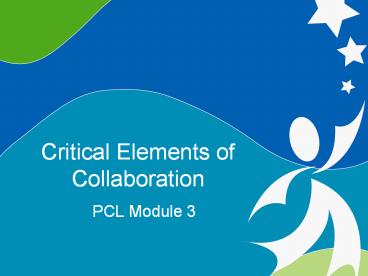Critical Elements of Collaboration - PowerPoint PPT Presentation
1 / 17
Title:
Critical Elements of Collaboration
Description:
Critical Elements of Collaboration PCL Module 3 Many collaborative teams encounter challenges around the process of decision-making. Most people agree that ... – PowerPoint PPT presentation
Number of Views:140
Avg rating:3.0/5.0
Title: Critical Elements of Collaboration
1
Critical Elements of Collaboration
- PCL Module 3
2
Objectives
- Define collaboration as it relates to parent
leadership and collaboration in a variety of
settings - Learn about the defining characteristics and
principles of collaboration - Define the elements of an effective collaborative
teaming process - Identify the stages of team development
3
Essential Questions
- What are the origins of collaboration and
collaborative teaming practices? - How is collaboration defined in the literature
and in practice? - What principles form the foundations of
collaboration? - What structures, processes, and practices
contribute to effective collaboration in a team
context?
4
Agenda Critical Elements of Collaboration
- Defining Collaboration (15 minutes)
- Metaphors for collaboration
- Rationale and context for collaboration
- Understanding Collaboration (45 minutes)
- Underlying principles
- Five essential elements for effective
collaborative practice - Stages of group development
5
Defining Collaboration Metaphors for
Collaboration
- Think about two situations in which you have
participated where collaboration was supposed to
occur. Think of one positive example, and one
negative. - For each example, think of a metaphor or image
that describes this situation. - Share your metaphor or image with one or two
partners. - Following your discussion, share your top 2
favorite metaphors with the whole group.
6
Understanding Collaboration
- The power point that follows highlights some of
the elements of collaboration that have been
written about in the literature. This literature
comes from the fields of psychology, education,
social services, and more recently, the business
world.
7
Underlying Principles and Characteristics of
Effective Collaborative Teams
8
I. Five Underlying Principles
- Collaboration
- Requires that all team members want to work
together towards a common goal - Is based on a sense that all participants are
valued - Embraces the unique perspectives of all team
members - Is based on a strong sense of purpose
- Requires trust and a sense of shared
responsibility
9
Key Assumptions
- Teams must value diverse membership and ideas
- Each member has expertise
- Teams must have a common purpose
- Team members need to trust one another
- Trust allows members to share in decision-making
and responsibility
10
II. Five Essential Characteristics
- Face-to-Face Interaction
- Positive Interdependence
- Interpersonal Skills
- Monitoring and Processing of Group Functioning
- Individual Accountability
11
Face-to-Face Interaction
- Regular opportunities to meet
- Must be convenient for all members
- Appropriate group size
- Literature suggests membership of 5 7 is best
- Effective communication systems
- Decide how communication will occur between
meetings (phone, e-mail, minutes, notebook, etc.)
12
Positive Interdependence
- Identify team goals and purpose
- Use distributed leadership functions
- Rotate roles, share tasks and resources
- Roles facilitator, recorder, time keeper
- Develop a common understanding of the groups
scope of work and authority - e.g., ask What kind of decision-making power
does this group have? - Identify common rewards and opportunities
13
Interpersonal Skills
- Develop group norms indicating desired
behaviors/types of communication - Examples arrive on time, respect diverse points
of view, no judging during creative
problem-solving - Develop communication and conflict resolution
skills - All group members need to practice their best
communication and collaboration skills - Learning to deal with conflict is key
14
Monitoring and Processing of Group Functioning
- Develop time and methods for regular processing
- Regular processing is key to the growth of the
group - Best to conduct processing at the end of each
meeting or on some other regular basis (e.g.,
once a month) - Its also good to take a deeper look one or two
times per year
15
Individual Accountability
- Use agendas
- Review agendas at the start of meetings add
items and identify time to be spent on each item - Use minutes indicating action items and to do
lists - Minutes need to identify decisions that were
made, and tasks to be completed by individual
group members - Identify strategies for building a sense of
responsibility - Rotate roles, share tasks, praise group and
individual accomplishments, etc.
16
Collaborative Decision-Making
- Identify and Use Specific Decision-Making
Processes - Consensus-based decision-making is most common in
collaborative groups - Sometimes consensus means deciding that I can
live with that - Democratic decision-making (i.e., voting) may be
used when consensus cannot be reached, as long as
the group agrees to this approach ahead of time
17
Final Thoughts on the 5 Characteristics of
Collaboration
- Which of the ideas presented above make the most
sense to you? - Which elements have you found most challenging in
your own experiences with teams? - What have we missed in thinking about
collaboration?

